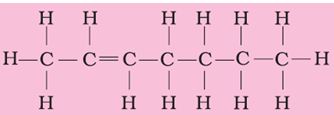CBSE 11TH CHEMISTRY - Online Test
Q1. Condense the following complete structural formula given below. Choose the appropriate answer given below


Answer : Option B
Explaination / Solution:
All the single bonds are broken and atoms are written together.
Q2. The term reduction has one of the following options taking place.
Answer : Option D
Explaination / Solution:
Reduction is addition of hydrogen, removal of oxygen, removal of an electronegative element or addition of an electropositive element.
- Removal of Oxygen: Reduction is a chemical reaction in which oxygen is removed from any chemical species (atom, ion or molecule).
CuO + C → Cu + CO
H2O + C → CO + H2
2CO + O2 → 2CO2
Fe3O4 + 4H2 → 3F2 + 4H2O - Addition of Hydrogen : Reduction is a chemical reaction in which hydrogen is added to any chemical species (atom, ion or molecule).
Cl2 + H2 → 2HCl
S + H2 → H2S
C2H4 + H2 → C2H6 - Removal of an Electronegative Element: Reduction is a chemical reaction in which an electronegative element is removed from any chemical species (atom, ion or molecule).
2HgCl2 + SnCl2 → Hg2Cl2 + SnCl4 (Reduction of mercuric chloride)
2FeCl3 + H2 → 2FeCl2 + 2HCl (Reduction of ferric chloride)
2FeCl3 + H2S → 2FeCl2 + 2HCl + S (Reduction of ferric chloride)
- Addition of an Electropositive Element: Reduction is a chemical reaction in which an electropositive element is added any chemical species (atom, ion or molecule).
HgCl2 + Hg → Hg2Cl2 (Reduction of mercuric chloride)
CuCl2 + Cu → Cu2Cl2 (Reduction of cupric chloride) - The substance which brings reduction is known as reducing agent.
- A substance, which undergoes oxidation, acts as a reducing agent while a substance, which undergoes reduction, acts as an oxidizing agent.
Mg, S, Cu, Na2SO3, H2S, HI, H2, C, KI are reducing agents, while O2, Cl2, F2, H2O2, MnO2, FeCl3, CuCl2, Fe3O4, CuO, etc., are oxidizing agents in the above examples.
- All oxidation and reduction reactions are complimentary of one another and occur simultaneously, one cannot take place without the other.
- No single oxidation and no single reduction process is known. The simultaneously oxidation and reduction reactions are generally termed as redox reactions. e.g., 2FeCl3 + SnCl2 → 2FeCl2 + SnCl4.
In above example iron undergoes reduction from +3 to +2.
Q3. Group I elements of the periodic table are collectively known as
Answer : Option D
Explaination / Solution:
Group I ( )elemens react vigorously with water to produce an alkaline solution thus colectively known as alkali metals
Q4. In the dynamic equilibrium stage, one of the following events take place. Choose the right one.
Answer : Option C
Explaination / Solution:
there is no change in the conc of reactant and product. At dynamic equilibrium, reactants are converted to products and products are converted to reactants at an equal and constant rate. Reactions do not necessarily—and most often do not—end up with equal concentrations. Equilibrium is the state of equal, opposite rates, not equal concentrations.
Q5. Which are three important states of matter ?
Answer : Option A
Explaination / Solution:
Three phases of matter are :
1. Solid - firm and stable in shape; not liquid or fluid, strongest intermolecular forces.
2. Liquid - A liquid is a nearly incompressible fluid that conforms to the shape of its container but retains a (nearly) constant volume independent of pressure. Intermediate molecular forces.
3. Gas -Takes the volume of the container, weakest intermolecular forces.
Q6. Saturated Hydrocarbons contain
Answer : Option C
Explaination / Solution:
saturated hydrocarbons are the compounds in which there is a single bond between the carbon atoms.They are also called alkanes and have the general formula CnH2n+2
Q7. Mendeleev arranged elements in a periodic table in order of their increasing atomic weights in such a way that the elements with similar properties occupies
Answer : Option C
Explaination / Solution:
Mendeleev arranged elements in horizontal rows and vertical columns of a table in order of their increasing atomic weights in such a way that the elements with similar properties occupied the same vertical column or group.This is because properties of elements are reapting after regular interval.
Q8. In an open system, which if the following take place ?
Answer : Option B
Explaination / Solution:
In open system there is flow of matter and energy in and out of the system or vice versa.
For example, an air compressor in which the air enters at a low pressure and exit at high pressure and there is energy interaction with the surrounding
Q9. The total energy of an electron in the first excited state of the hydrogen atom is about −3.4 eV. What is the kinetic energy of the electron in this state?
Answer : Option B
Explaination / Solution:
Total energy of the electron, E = −3.4 eV
Kinetic energy of the electron is equal to the negative of the total energy.
K = −E = − (− 3.4) = +3.4 eV
Hence, the kinetic energy of the electron in the given state is +3.4 eV.
Q10. Dichloro-diphenyl-trichloro-ethane (DDT), plastic materials, heavy metals etc. belong to which of the following category of pollutants in environment :
Answer : Option D
Explaination / Solution:
DDT, plastic materials and heavy metals like cadmium, mercury and arsenic are not degradable by natural biological processes by bacteria or any other microbe. Therefore they are non-biodegradable.
